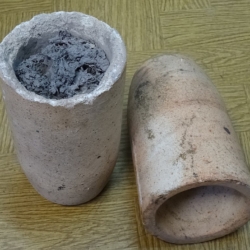Contributor(s): Shared on: Categories: Tags: | Source (Hebrew) | Translation (English) |
|---|
לַמְנַצֵּ֣חַ בִּ֭נְגִינוֹת עַֽל־הַשְּׁמִינִ֗ית
מִזְמ֥וֹר לְדָוִֽד׃
|
A David Song
(Note to the Conductor — play this melody on the eight stringer) |
יְֽהוָ֗ה אַל־בְּאַפְּךָ֥ תוֹכִיחֵ֑נִי
וְֽאַל־בַּחֲמָתְךָ֥ תְיַסְּרֵֽנִי׃
חָנֵּ֥נִי יְהוָה֮
כִּ֤י אֻמְלַ֫ל אָ֥נִי
רְפָאֵ֥נִי יְהוָ֑ה כִּ֖י נִבְהֲל֣וּ עֲצָמָֽי׃
וְ֭נַפְשִׁי נִבְהֲלָ֣ה מְאֹ֑ד
ואת [וְאַתָּ֥ה] יְ֝הוָ֗ה
עַד־מָתָֽי׃
|
Yah! Please don’t chide me in Your anger.
Don’t scold me in Your wrath.
I need You to show me kindness.
I am so miserable.
Heal me, Yah! My bones ache so.
My inner self is very troubled.
I ask You, Yah!
How long must I still endure? |
שׁוּבָ֣ה יְ֭הוָה
חַלְּצָ֣ה נַפְשִׁ֑י
ה֝וֹשִׁיעֵ֗נִי לְמַ֣עַן חַסְדֶּֽךָ׃
כִּ֤י אֵ֣ין בַּמָּ֣וֶת זִכְרֶ֑ךָ
בִּ֝שְׁא֗וֹל
מִ֣י יֽוֹדֶה־לָּֽךְ׃
|
Relent, Yah,
And for mercy’s sake
Pull me out and spare me.
How can I remember You
If I am dead in the pits?
Who will thank You? |
יָגַ֤עְתִּי ׀ בְּֽאַנְחָתִ֗י אַשְׂחֶ֣ה
בְכָל־לַ֭יְלָה מִטָּתִ֑י
בְּ֝דִמְעָתִ֗י עַרְשִׂ֥י אַמְסֶֽה׃
עָֽשְׁשָׁ֣ה
מִכַּ֣עַס עֵינִ֑י
עָֽ֝תְקָ֗ה
בְּכָל־צוֹרְרָֽי׃
|
I groan and am all worn out.
I sob on my bed;
My tears drench my mattress.
My eyes are stinging
From frustration,
As if all my troubles
Wept them out. |
ס֣וּרוּ מִ֭מֶּנִּי
כָּל־פֹּ֣עֲלֵי אָ֑וֶן
כִּֽי־שָׁמַ֥ע יְ֝הוָ֗ה ק֣וֹל בִּכְיִֽי׃
שָׁמַ֣ע יְ֭הוָה תְּחִנָּתִ֑י
יְ֝הוָ֗ה תְּֽפִלָּתִ֥י יִקָּֽח׃
יֵבֹ֤שׁוּ ׀ וְיִבָּהֲל֣וּ מְ֭אֹד
כָּל־אֹיְבָ֑י
יָ֝שֻׁ֗בוּ
יֵבֹ֥שׁוּ
רָֽגַע׃
|
Away with you,
All you traffickers of sin!
Yah has heard my wailing.
Yah has listened to my pleading.
Yah will fulfill my prayer.
Confusion and embarrassment
On you, you fiends!
This very moment,
Let shame
Bring you to your senses. |
Rabbi Zalman Schachter-Shalomi, z”l, included his translation of the prayer Psalms 6 in his Siddur Tehillat Hashem Yidaber Pi (2009). To the best of my ability, I have set his English translation side-by-side with the Hebrew verses comprising the psalm. –Aharon N. Varady Source
 Rabbi Dr. Zalman Meshullam Schachter-Shalomi, affectionately known as "Reb Zalman" (28 August 1924 – 3 July 2014) was one of the founders of the Jewish Renewal movement. Born in Żółkiew, Poland (now Ukraine) and raised in Vienna, he was interned in detention camps under the Vichy Regime but managed to flee the Nazi advance, emigrating to the United States in 1941. He was ordained as an Orthodox rabbi in 1947 within the ḤaBaD Hasidic movement while under the leadership of the sixth Lubavitcher Rebbe, Yosef Yitzchok Schneersohn, and served ḤaBaD communities in Massachusetts and Connecticut. He subsequently earned an M.A. in psychology of religion at Boston University, and a doctorate from the Hebrew Union College. He was initially sent out to speak on college campuses by the Lubavitcher Rebbe, but in the early 1960s, after experimenting with "the sacramental value of lysergic acid", the main ingredient in LSD, leadership within ḤaBaD circles cut ties with him. He continued teaching the Torah of Ḥassidut until the end of his life to creative, free and open-minded Jewish thinkers with humility and kindness and established warm ecumenical ties as well. In September 2009, he became the first contributor of a siddur to the Open Siddur Project database of Jewish liturgy and related work. Reb Zalman supported the Open Siddur Project telling its founder, "this is what I've been looking forward to!" and sharing among many additional works of liturgy, an interview he had with Havurah magazine in the early to mid-1980s detailing his vision of " Database Davenen." The Open Siddur Project is proud to be realizing one of Reb Zalman's long held dreams. David ben Yishai was the second king of the United Kingdom of Israel and Judah, reigning ca. 1010–970 BCE. While almost half of the Psalms are headed "l'David" and tradition identifies several with specific events in David’s life (e.g., Psalms № 3, 7, 18, 34, 51, 52, 54, 56, 57, 59, 60, 63 and 142), most scholars consider these headings to be late additions and that no psalm can be attributed to David with certainty. 1 Samuel 16:15-18 describes David as a skillful harp (lyre) player and "the sweet psalmist of Israel." The Mesorah (Heb: מָסוֹרָה) a/k/a, the Masoretic text is the authoritative Hebrew and Aramaic text of the TaNaKh for Karaite and Rabbinic Judaism. It was primarily copied, edited and distributed by a group of Jews known as the Masoretes between the 7th and 10th centuries CE. The Masoretic Text defines the Jewish canon and its precise letter-text, with its vocalization and accentuation known as the Masorah. Read a comment / Leave a comment (moderated) Works of related interest: |












Leave a Reply